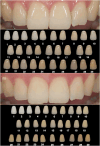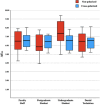Effect of different instrumental techniques and clinical experience on shade matching
- PMID: 38872321
- PMCID: PMC12235217
- DOI: 10.1111/jopr.13894
Effect of different instrumental techniques and clinical experience on shade matching
Abstract
Purpose: Many factors can affect the aesthetics of dental restorations, including the instrumental techniques used in shade matching, and can lead to clinical failure. The aim of this study was to investigate the effectiveness of using the cross-polarization digital photograph technique and intraoral scanners for shade matching, and also evaluate the effect of the level of clinical experience on shade matching success.
Materials and methods: Color analysis was performed on the maxillary right central incisors of 10 subject models with Vita Easyshade. Intraoral scanning was performed 10 times on each model using TRIOS 3 and color analysis was performed from the same spot. Then cross-polarized and non-polarized photographs of the models were taken with standard settings using a gray reference card. Each shade tab of the Vita System 3D-Master scale was also photographed with two different polarization techniques. Four groups (n = 12), including prosthodontics faculty staff, postgraduate students in prosthodontics, undergraduate students, and dental technicians matched the shade tabs and the model photographs obtained with both techniques on a standardized computer screen. Finally, the color differences between the shade tabs and maxillary central incisors matched by observers from four different groups were recorded using a colorimeter, Classic Color Meter, in accordance with the CIELAB system and CIEDE2000 (ΔE00) values were calculated. The data were compared with the acceptability threshold of 1.80 for ΔE00. The data obtained from the observers were analyzed with IBM SPSS Statistics 26.0 Release Notes program. Independent Samples t-test was used to compare normally distributed data according to binary groups. The level of significance was 0.05.
Results: A statistically significant difference was found in the shade matching on photographs taken with different techniques in postgraduate students (p = 0.02). Also, there was a statistically significant difference in success between the groups that made shade matching based on photographs obtained with the non-polarization technique (p = 0.00). The undergraduate students achieved statistically significantly lower results than all other groups (ΔE00 = 5.57 ± 1.07). The kappa value between the intraoral scanner and spectrophotometer results was 0.10, and this value was not statistically significant (p = 0.32).
Conclusions: The cross-polarization technique used especially for shade matching is not superior to the non-polarization technique. Academic and clinical experience might be correlated with shade-matching success with the non-polarization technique. The clinical acceptability threshold could not be achieved in the shade matchings made on digital photographs taken with both techniques. Shade matching performed with an intraoral scanner did not yield reliable results.
Keywords: color analysis; cross‐polarization; digital photography; intraoral scanner; shade matching.
© 2024 The Author(s). Journal of Prosthodontics published by Wiley Periodicals LLC on behalf of American College of Prosthodontists.
Conflict of interest statement
The authors declare no conflicts of interest.
Figures






Similar articles
-
The effect of thermal aging on the color matching of Class III and Class V restorations with universal resin composites in various-shade human teeth: an instrumental and visual evaluation.Clin Oral Investig. 2025 Jun 26;29(7):360. doi: 10.1007/s00784-025-06439-6. Clin Oral Investig. 2025. PMID: 40569452 Free PMC article.
-
Effects of ambient lighting conditions on the scanning accuracy and shade matching capability of intraoral scanners: an in vitro study.BMC Oral Health. 2025 Jul 3;25(1):1088. doi: 10.1186/s12903-025-06446-9. BMC Oral Health. 2025. PMID: 40611175 Free PMC article.
-
Analysis of Aesthetic Preferences Regarding Gingival-Dental Color Combinations.J Esthet Restor Dent. 2025 Sep;37(9):2060-2071. doi: 10.1111/jerd.13498. Epub 2025 Jun 10. J Esthet Restor Dent. 2025. PMID: 40492825 Free PMC article.
-
The Role of Intraoral Scanners in the Shade Matching Process: A Systematic Review.J Prosthodont. 2023 Mar;32(3):196-203. doi: 10.1111/jopr.13576. Epub 2022 Aug 16. J Prosthodont. 2023. PMID: 35919949
-
Effect of assessor's sex on visual color matching in dentistry: A systematic review of the literature.J Esthet Restor Dent. 2022 Mar;34(2):383-396. doi: 10.1111/jerd.12839. Epub 2021 Nov 29. J Esthet Restor Dent. 2022. PMID: 34843155
Cited by
-
Clinical assessment of dental color during dehydration and rehydration by various dental photography techniques.Odontology. 2025 Mar 10. doi: 10.1007/s10266-025-01081-w. Online ahead of print. Odontology. 2025. PMID: 40063225
References
-
- Schropp L. Shade matching assisted by digital photography and computer software. J Prosthodont. 2009;18:235–241. - PubMed
-
- Wee AG, Monaghan P, Johnston WM. Variation in color between intended matched shade and fabricated shade of dental porcelain. J Prosthet Dent. 2002;87:657–666. - PubMed
-
- Okubo SR, Kanawati A, Richards MW. Evaluation of visual and instrument shade matching. J Prosthet Dent. 1998;80:642–648. - PubMed
-
- Geary JL, Kinirons MJ. Use of a common shade guide to test the perception of differences in the shades and value by members of the dental team. Prim Dent Care. 1999;6:107–110. - PubMed
-
- Lagouvardos PE, Diamanti H, Polyzois G. Effect of individual shades on reliability and validity of observers in colour matching. Eur J Prosthodont Restor Dent. 2004;12:51–56. - PubMed
MeSH terms
Grants and funding
LinkOut - more resources
Full Text Sources

